The GIGABYTE Z170X-Gaming G1 Review: Quad-SLI on Skylake, and now with Thunderbolt 3
by Ian Cutress on December 1, 2015 9:30 AM EST- Posted in
- Motherboards
- Gaming
- Intel
- Gigabyte
- PLX
- PLX8747
- Z170
- Thunderbolt 3
Gaming Performance 2015
Our 2015 gaming results are still relatively new, but the issue of FCLK settings might play a big role here. At launch, the default setting for the communication buffer between the CPU and PCIe stack was 800 MHz, even though Intel suggested 1000 MHz, but this was because of firmware limitations from Intel. Since then, there is firmware to enable 1000 MHz, and most motherboard manufacturers have this - but it is unclear if the motherboard will default to 1000 MHz and it might vary from BIOS version to BIOS version. As we test at default settings, our numbers are only ever snapshots in time, but it leads to some interesting differences in discrete GPU performance.
Alien: Isolation
If first person survival mixed with horror is your sort of thing, then Alien: Isolation, based off of the Alien franchise, should be an interesting title. Developed by The Creative Assembly and released in October 2014, Alien: Isolation has won numerous awards from Game Of The Year to several top 10s/25s and Best Horror titles, ratcheting up over a million sales by February 2015. Alien: Isolation uses a custom built engine which includes dynamic sound effects and should be fully multi-core enabled.
For low end graphics, we test at 720p with Ultra settings, whereas for mid and high range graphics we bump this up to 1080p, taking the average frame rate as our marker with a scripted version of the built-in benchmark.
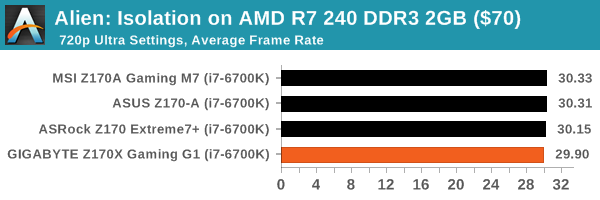
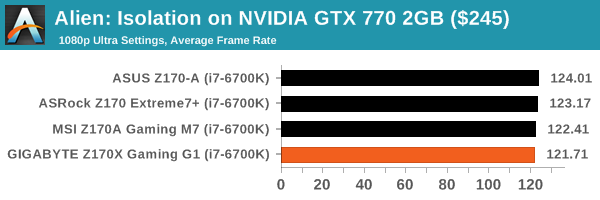
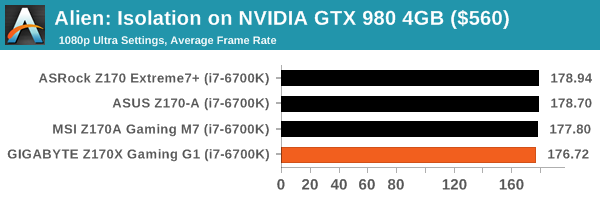
Total War: Attila
The Total War franchise moves on to Attila, another The Creative Assembly development, and is a stand-alone strategy title set in 395AD where the main story line lets the gamer take control of the leader of the Huns in order to conquer parts of the world. Graphically the game can render hundreds/thousands of units on screen at once, all with their individual actions and can put some of the big cards to task.
For low end graphics, we test at 720p with performance settings, recording the average frame rate. With mid and high range graphics, we test at 1080p with the quality setting. In both circumstances, unlimited video memory is enabled and the in-game scripted benchmark is used.

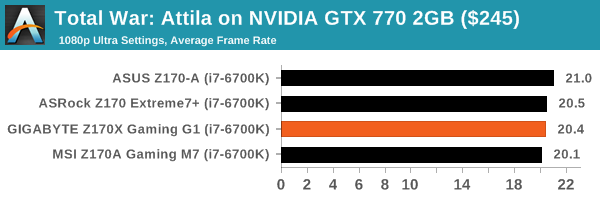
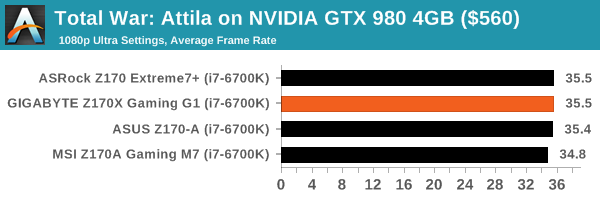
Grand Theft Auto V
The highly anticipated iteration of the Grand Theft Auto franchise finally hit the shelves on April 14th 2015, with both AMD and NVIDIA in tow to help optimize the title. GTA doesn’t provide graphical presets, but opens up the options to users and extends the boundaries by pushing even the hardest systems to the limit using Rockstar’s Advanced Game Engine. Whether the user is flying high in the mountains with long draw distances or dealing with assorted trash in the city, when cranked up to maximum it creates stunning visuals but hard work for both the CPU and the GPU.
For our test we have scripted a version of the in-game benchmark, relying only on the final part which combines a flight scene along with an in-city drive-by followed by a tanker explosion. For low end systems we test at 720p on the lowest settings, whereas mid and high end graphics play at 1080p with very high settings across the board. We record both the average frame rate and the percentage of frames under 60 FPS (16.6ms).
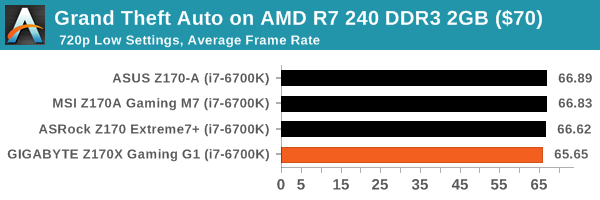
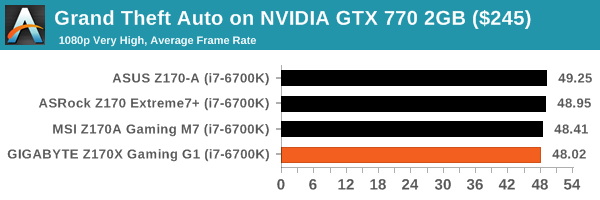
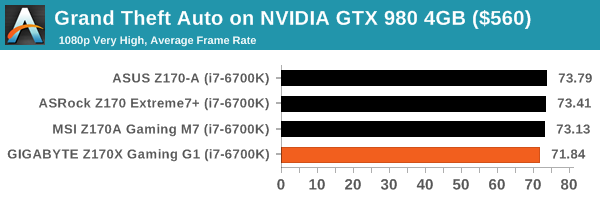
GRID: Autosport
No graphics tests are complete without some input from Codemasters and the EGO engine, which means for this round of testing we point towards GRID: Autosport, the next iteration in the GRID and racing genre. As with our previous racing testing, each update to the engine aims to add in effects, reflections, detail and realism, with Codemasters making ‘authenticity’ a main focal point for this version.
GRID’s benchmark mode is very flexible, and as a result we created a test race using a shortened version of the Red Bull Ring with twelve cars doing two laps. The car is focus starts last and is quite fast, but usually finishes second or third. For low end graphics we test at 1080p medium settings, whereas mid and high end graphics get the full 1080p maximum. Both the average and minimum frame rates are recorded.
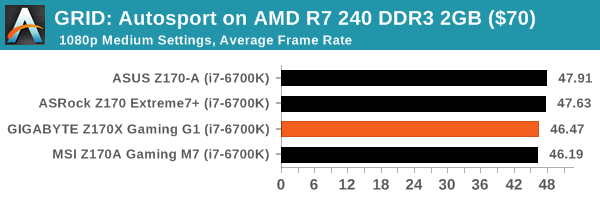

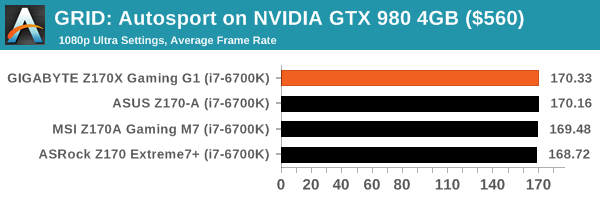
Middle-Earth: Shadows of Mordor
The final title in our testing is another battle of system performance with the open world action-adventure title, Shadows of Mordor. Produced by Monolith using the LithTech Jupiter EX engine and numerous detail add-ons, SoM goes for detail and complexity to a large extent, despite having to be cut down from the original plans. The main story itself was written by the same writer as Red Dead Redemption, and it received Zero Punctuation’s Game of The Year in 2014.
For testing purposes, SoM gives a dynamic screen resolution setting, allowing us to render at high resolutions that are then scaled down to the monitor. As a result, we get several tests using the in-game benchmark. For low end graphics we examine at 720p with low settings, whereas mid and high end graphics get 1080p Ultra. The top graphics test is also redone at 3840x2160, also with Ultra settings, and we also test two cards at 4K where possible.
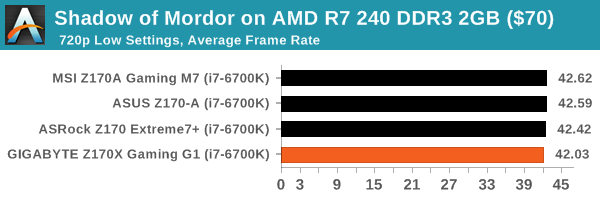
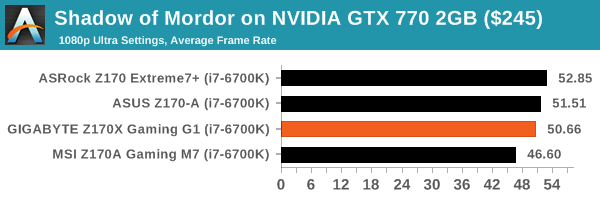
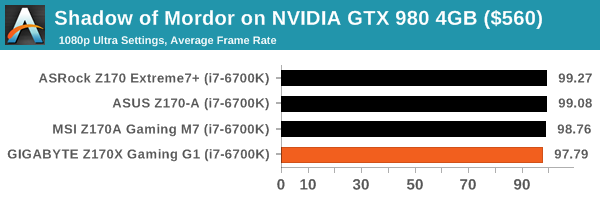
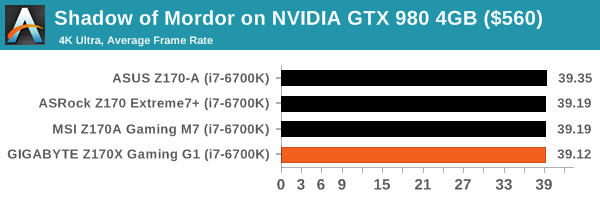















67 Comments
View All Comments
WasHopingForAnHonestReview - Wednesday, December 2, 2015 - link
Bingo.Mikemk - Tuesday, December 1, 2015 - link
What about a 5820k in an ASUS X99-E WS?Mikemk - Tuesday, December 1, 2015 - link
EDIT: I should clarify, I agree this is too expensive, but there are use cases (mainly with compute and servers) where it can be legitimate to have the motherboard cost more than the CPURaistlinZ - Tuesday, December 1, 2015 - link
Wouldn't someone buying a workstation mobo want a Xenon CPU, not a consumer grade CPU?Mikemk - Tuesday, December 1, 2015 - link
Well, if they just want GPU power with 7 GPUs, and doesn't care about CPU performance, the 5820k is relatively cheap way to get the system to bootGigaplex - Tuesday, December 1, 2015 - link
The 5820k has cut down PCIe lanes. You'd want the next model up for that many GPUs.bizude - Monday, December 14, 2015 - link
You could run a 3-way setup on a 5820k using 3.0x8/3.0x8/3.0x8 - just not a 4-way.jasonelmore - Tuesday, December 1, 2015 - link
A motherboard should cost more than the CPU. It has waaay more materials, Chips, Wifi, Controllers, Metal, Copper, Fiberglass, Connectors, Software, Cables, Features etc..,han a simple CPU made with .0005 gram of gold and even less copper. Mostly sand and aluminum.
thank intel for their 60% profit margin, where-as these boards have 20-30% margins
Zotamedu - Tuesday, December 1, 2015 - link
So no test of the most important feature, the quad SLI support? Running two GPUs in x8/x8 tends to work well but what happens when you kick in a third or fourth so you end up with x8/x8/x8/x8 that is multiplexed into a single x16? The PCIe bandwidth can be limited at x8/x8, how does the multiplexer perform?jasonelmore - Tuesday, December 1, 2015 - link
yeah i know right, he even states he has 4 290x's in his test setup.. didnt even run the test on it.